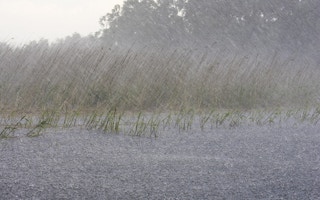Current climate models appear to underestimate the full impact of forest vegetation on rainfall patterns, indicating that the potential consequences of land-cover change on global temperature increase cannot be assessed with certainty, new research shows.
Erratic rainfall could worsen with deforestation, according to Douglas Sheil, an ecologist at the Norwegian University of Life Sciences and an associate researcher with the Center for International Forestry Research (CIFOR).
Forest cover change could also be behind a perceived eastward shift of the rainfall zone over Southeast Asia, with a potential regional and global impact that may have been demonstrated by the ferocity of fires in Sumatra, Indonesia, in 2013 that caused a thick haze, Sheil said.
“Vegetation probably has an even bigger effect on climate than we’ve realized,” said Sheil, who argues in a new paper that the findings require urgent attention from scientists who study plants and forests.
“
In the tropics, large-scale loss of forest cover is generally associated with less rain and weakening monsoons, although the full impact of a dryer climate is not yet fully understood by scientists. Standard models used to forecast climate change take into account the physical properties of forests — the way they reflect sunlight or the friction created as wind blows over them — but overlook biological processes that could affect air flow and cloud formation significant for rain production
Douglas Sheil, ecologist, Norwegian University of Life Sciences
In the tropics, large-scale loss of forest cover is generally associated with less rain and weakening monsoons, although the full impact of a dryer climate is not yet fully understood by scientists. Standard models used to forecast climate change take into account the physical properties of forests — the way they reflect sunlight or the friction created as wind blows over them — but overlook biological processes that could affect air flow and cloud formation significant for rain production, Sheil said.
Precipitation is formed when the atmosphere draws moisture from oceans as water vapor, which condenses and falls as rain, hail or snow. Globally, about two-thirds of this precipitation returns to the atmosphere as water vapor, and the majority of that falls again on land.
A recent study, cited in Sheil’s paper, showed that winds travelling through forests typically produce more than twice as much rain as those that blow over open land, leading to predictions from scientists that by 2050, the tropics could see a 12 percent and 21 percent decline in wet and dry season precipitation, respectively.
Tree transpiration
The moisture that trees absorb through their roots later evaporates through pores in their leaves called stomata. Vegetation may contribute as much as 90 percent of the moisture in the atmosphere derived from land surfaces — far more than earlier estimates, according to recent research. Trees produce flows of water vapor that are typically more than 10 times greater than from herbaceous vegetation per unit of land area, surpassing those produced by wet ground or open water. Transpiration “is an active biological process” that is not fully reflected in the physics of climate models, Sheil said.
For example, increasing atmospheric carbon dioxide could lead to larger, denser forests that store more carbon, he said, but it could also affect the amount of atmospheric moisture they produce — and, therefore, the amount of rainfall over the forest and downwind.
“Increased carbon dioxide reduces the need for plants to keep their stomata open. One response is that they close their stomata more, so they transpire less, and they can produce the same amount of growth with less transpiration,” Sheil said. “If there’s less transpiration, that has a huge impact on climate. That’s an active biological response to increased carbon dioxide — it’s not just physics,” and it doesn’t enter into climate models based solely on physical principles, he said.
The biology and physics may be more closely intertwined than previously believed, according to an idea about the way in which forests make the rain that keeps them growing.
Biotic pump
One of the more controversial suggestions is that forests influence atmospheric pressure. This concept, called the “biotic pump,” posits that moist air is drawn in as it rises over forested regions, then it condenses and creates a low-pressure area that draws in more moist air, creating a positive feedback loop.
Deforestation breaks the cycle, disrupting precipitation and making it more variable, not only by reducing transpiration and cloud formation, but also by slowing or disrupting the flow of air inland from coastal areas. That means less moisture arrives from outside the region to fall as rain, resulting in further drying of the forest, and less transpiration and precipitation. This sets up a negative feedback loop that could — in an extreme scenario — change a moist forest region into a dry environment.
“If forests are potentially driving those air currents, when we lose a significant amount of forest, or transpiration declines with increased atmospheric carbon dioxide, we might expect to see a weakening of those winds,” Sheil said. “And that’s what has been identified across the tropics and sub-tropics, although we still are not certain of the cause.”
Tree to cloud
Trees also influence cloud formation by emitting carbon-based chemicals called volatile organic compounds (VOCs) into the atmosphere.
Some of those compounds are deposited on tiny airborne particles such as dust, bacteria, pollen and fungal spores. As the particles grow with the deposition of VOCs, they promote condensation and gather the resulting moisture, hastening cloud formation, Sheil said.
One study found 555 different VOCs over a single citrus orchard in California. Research in the Amazon suggests that such aerosols may play a key role in both the hydrological cycle and biological reproduction in the forest.
“It’s amazingly complex, and in a sense we’re still kind of in the dark ages,” Sheil said. “There is a link, but we don’t really understand it.”










